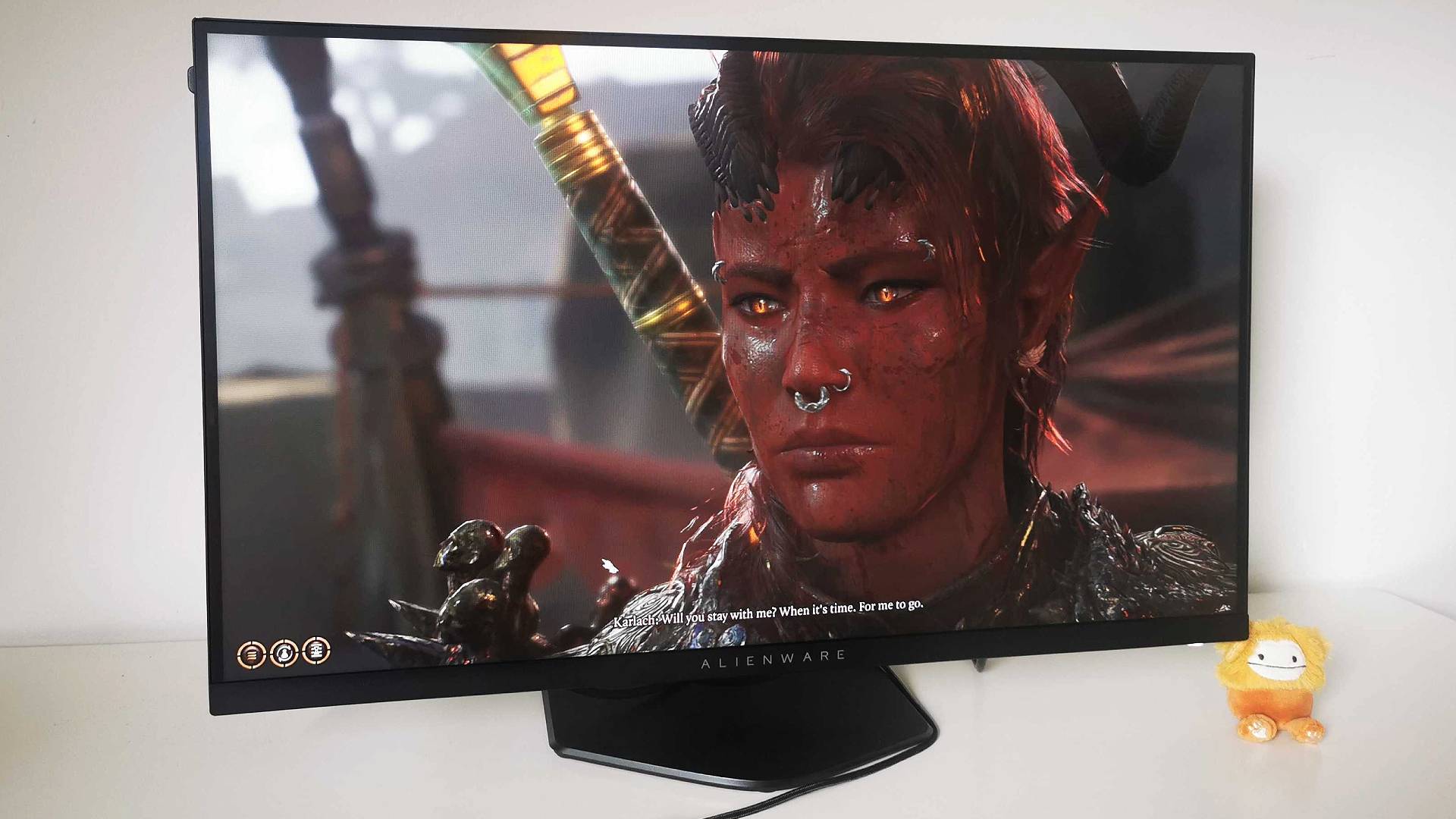GamesRadar+ Verdict
The Alienware AW2724HF is an excellent option for anyone who takes competitive gaming seriously. Its 360Hz panel is a heavy hitter in fast-paced shooters, and it’s noticeably more responsive than other lower refresh rate screens I’ve tested. However, this display is probably best suited to Esports enthusiasts since resolution, contrast, and color accuracy all take a back seat. If you’re debating whether or not you should upgrade to 500Hz, you should perhaps consider this monitor first.
Pros
- +
Super responsive
- +
Nice selection of overlays
- +
Plenty of ports
Cons
- -
1080p shows its wrinkles
- -
Color and contrast are lacking
Why you can trust GamesRadar+
High refresh rate screens are arguably niche, and the Alienware AW2724HF caters to a specific competitive audience. Yet, the benefits of 360Hz displays are now clearer to me than ever, especially if you’re looking to harness every frame in frantic gunfights. I’m anything but an Esports pro, but I can’t imagine ever needing 500Hz after using Dell’s second-fastest screen, especially since matching such specs comes with a lot of visual compromises.
Arguably, the best gaming monitor out there should strike a nice balance between high refresh rate and resolution. That said, Dell’s 360Hz Alienware display knows it’s not going to win over everyone with its need for speed, and there are still plenty of players out there happy to play games at 1080p. Am I one of those people? Sort of. However, I’m pretty rubbish at FPS games, not to mention I’m the sort of person who gets distracted looking at pretty textures and lighting when I’m meant to be spraying bullets.
That’s not to say I don’t think 360Hz is worthwhile, though, and the Alienware AW2724HF can pat itself on the back for convincing me otherwise. I personally don’t think the practical jump from 240Hz is huge, but it's enough to prove its worth if your gaming PC is actually able to churn out a matching frame rate. That latter factor is key, as unless you’re a CS:GO player who embraces potato quality to gain responsiveness, harnessing 360Hz is a bit of a chore.
Specs
Commanding a $459.99 price point, the Alienware AW2724HF is one of the pricer 1080p monitors around, and that’s thanks to its refresh rate. The specs on display here all link to responsiveness, and the 27-inch IPS screen checks all the boxes when it comes to competitive performance (at least on paper).
| Price | $459.99 / £399.00 |
| Screen size | 27-inch |
| Screen type | IPS |
| Resolution | 1920 x 1080 |
| Refresh rate | 360Hz |
| Brightness | 400 cd/m² |
| Response time | 0.5ms GtG |
| Viewing angle | 178° / 178° |
| Contrast ratio | 1,500,000:1 |
| Color support | 16.8 million colors |
| Inputs | 1x HDMI, 1x Display Port 1.4, 4x USB-A, 3.5mm auxiliary audio output |
| Weight | 9.22 lb (4.18 kg) |
Specifically, we’re talking about a 0.5ms minimum response time when using ‘extreme mode’, making it one of the snappiest screens around. In addition, it’s armed with VESA Adaptive-Sync support to combat any tearing and HDR10, which is nice to have given the focus is on speed rather than image quality.
As for ports, the AW2724HF is kitted out with two DisplayPort 1.4 ports, an HDMI that supports up to 255Hz, and a four-port USB 3.2 hub. In other words, Dell hasn’t skimped when it comes to physical specs, as the monitor boasts an IO on par with the best models out there.
Design
For an Alienware product, the AW2724HF is surprisingly subtle in terms of design. Dell’s “Dark Side of the Moon” colorway is really just code for matte black, and the only standout trails you’ll notice at a glance are the branding along the bottom bezel and its hexagonal base.
It might be all business at the front, but there are traces of a unique party happening around the back. That unique base mentioned above is attached to a curvy adjustable stand, which sets it apart from the kind of Dell monitor you’d find kicking around your work office. It’s certainly not as eye-catching as the company’s Alienware Aurora R15 rig, and that’s potentially a good thing. Still, I would have enjoyed some extra aesthetic flair, as the package is a bit visually unremarkable.
If you’re into practical design choices, you’ll be delighted at what the AW2724HF has to offer. The click-fit stand helps the monitor leap from box to desk within seconds, and it’s easy to adjust both tilt and height. However, I did sadly struggle when it came to hooking my PC up, as all the ports are kept under a lip. Dell isn’t the only monitor maker guilty of this, but I’m always holding out for an easy-to-reach IO that doesn’t require fumbling around with wires.

Speaking of fumbling, the AW2724HF uses one of those joystick nubs as an OSD input device, similar to the Philips Momentum 5000 27M1F5800. Yes, I know, the fact more and more monitors are starting to include remotes has spoiled me, but that doesn’t excuse how irritating all-in-one menu buttons are to use. I also almost missed the power button entirely, as it’s hiding on the right-hand side under a bezel with no standby illumination. It weirdly lights up when pressed, which feels a bit silly given it’s not even visible unless you peer under.
I’m a bit of a sucker for quirky extras, and I was delighted to find a pop-out headphone arm in the top left corner. Its inclusion makes total sense considering the monitor’s target audience - if you’re into competitive shooters, you’ve probably got a high-spec gaming headset you’ll want to keep at arm’s reach. I mean, that’s not what I’m currently using it for, I’ve got a little Bigfoot plush perched on it instead, so take from that what you will.
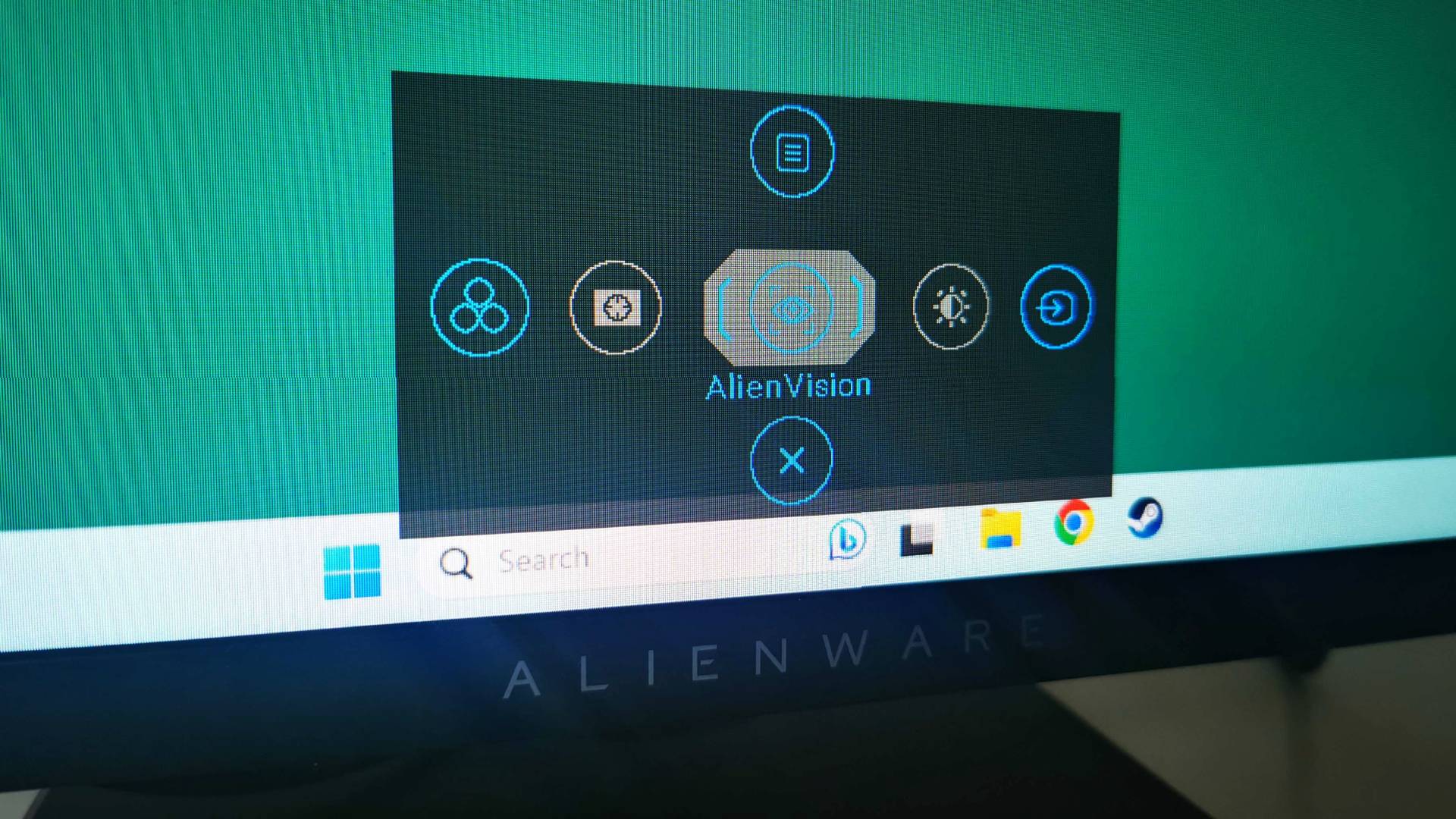
Features
The Alienware AW2724HF’s menu looks pretty busy, but you’ll find the usual array of monitor features dwelling within. That includes standard settings like pre-sets, inputs, display adjustments, and screen care functions (the kind you’d usually find on an OLED display). Don’t worry, though, there are some Alien features mixed in with the necessary and mundane, and they largely fall under a category dubbed Alienvision.
What is Alienvision? It’s effectively a collection of overlays that some competitive players may find useful. Options include night vision and chroma-style central visors, a clear focus box that blurs everything that isn’t within the center, and a crosshair. Maybe I’ve got an overactive imagination, but Dell’s unique menu gives me Predator vibes, but I’m not sure if I’d actively put the featureset to good use.
Since this screen is armed with HDR10 support, the Alienware AW2724HF has its own dedicated ‘smart HDR’ menu. It includes some genre-based pre-sets, but there’s an option that allows you to set contrast and brightness manually too. I’m quite a big fan of this, as it means I can tailor things to my liking while still retaining the ability to activate a pre-set if the need arises without wiping any global settings. HDR is rarely consistent, so maintaining flexible settings is vital if you want things to look their best.
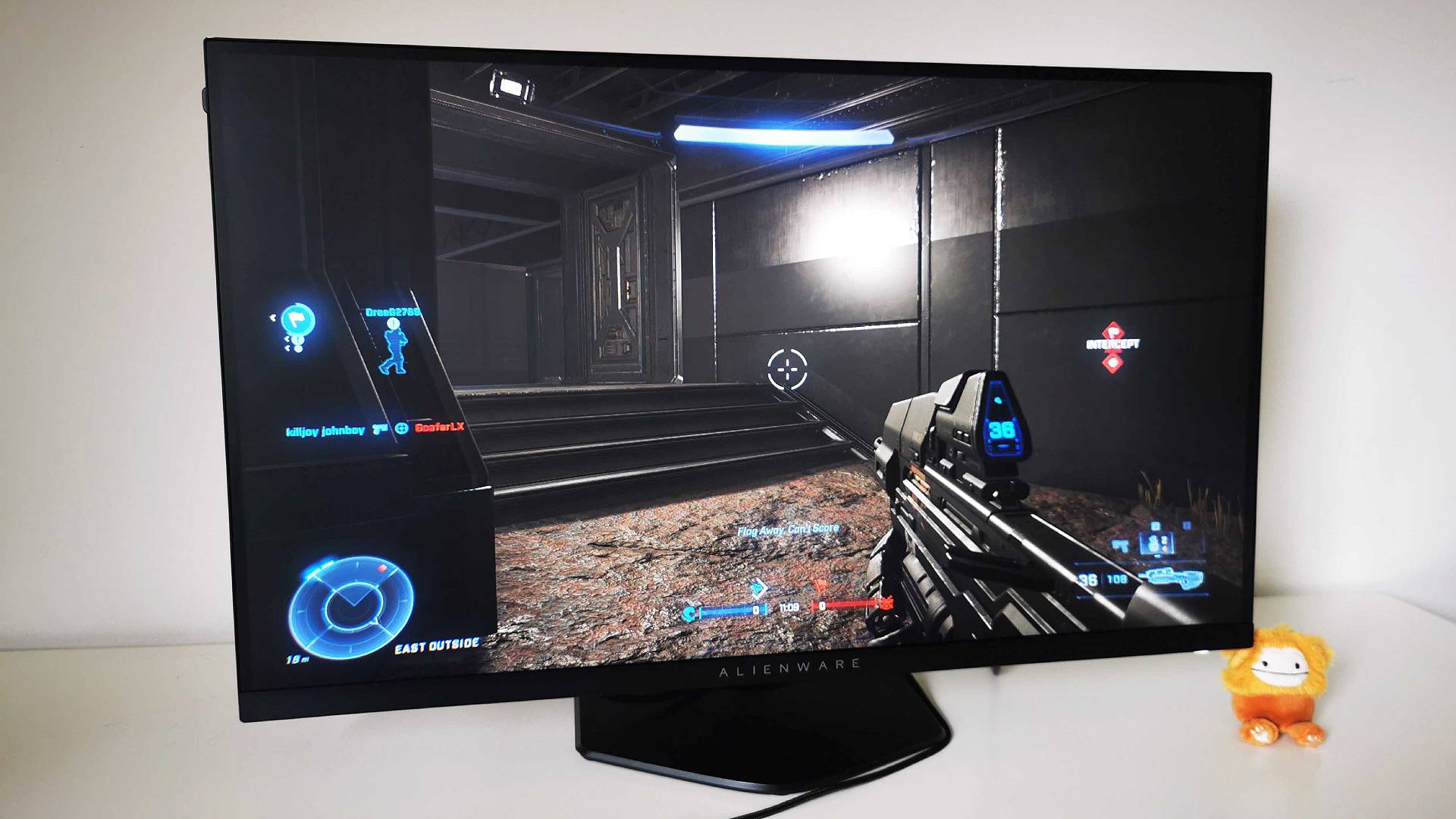
Performance
The Alienware AW2724HF is designed with speed in mind, so I thought it was about time I started revisiting my usual FPS haunts. In a way, the rust accumulated from not playing Halo Infinite for the best part of a year is handy, as it helps demonstrate whether this 360Hz screen can provide even the worst Spartans with an edge. My experience re-entering multiplayer matches may be slightly anecdotal, but allow me to fill you in on how I got on anyway.
When I say my Spartan suit is rusty, I mean rusty. At first, my fingers fumbled around looking for familiar keys with high school gym class levels of grace (let’s just say I was very uncoordinated). And yet, the responsiveness of the AW2724HF while playing at between 200-360fps enabled me to quickly get the hell out of dodge and prevent embarrassing KD ratios during my first few sessions. Within no time, I was back to gunning down the red team while sprinting across the map, and it felt fantastic.
With my newfound confidence now in effect, I decided to also give Overwatch 2 a whirl, a game I’ve been dipping in and out of this year. Again, Alienware’s speedy panel provided smooth, responsive visuals that enhanced my reaction tenfold. Did I still sort of suck compared to my online comrades? Well, yes, splashing out on an Esports-grade monitor isn’t going to change that fact. Still, I felt like every movement translated truer than ever on screen, and that’s the part that matters.
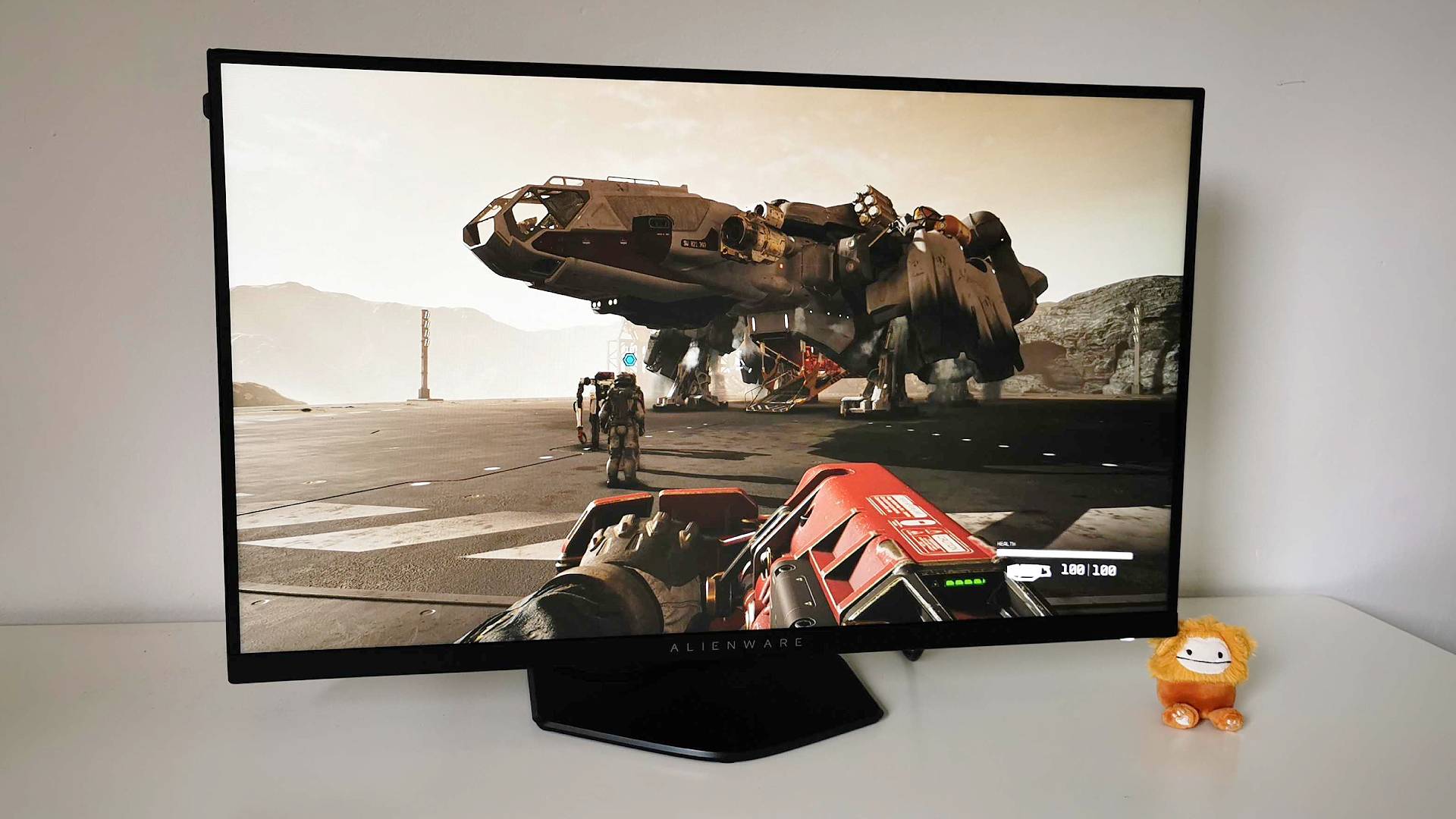
We’ve established that the AW2724HF is fast, but I also put the panel through its paces when it comes to fidelity. I normally use a 4K 144Hz display as my daily driver, so I was expecting some differences in some scenarios, and testing proved that my eyeballs have less tolerance for 1080p than before.
As a surprise to absolutely no one, I’m still making my way through Baldur’s Gate 3, and the AW2724HF fell short while serving as a portal to Faerun. With ultra settings enabled, textures and character models looked more pixelated than I was anticipating, which is perhaps symptomatic of the D&D game’s busy design and 1080p stretched over 27 inches. Not that I think that’s a resolution and screen size mismatch, but it certainly felt like it in BG3.
I started testing the AW2724HF just as Starfield landed, and I wasn’t about to let 1080p stop me from exploring the stars. Visually, Bethesda’s interstellar RPG doesn’t look half bad on the 360Hz screen, and it certainly doesn’t look as pixelated as Baldur’s Gate 3. Weirdly, the shooter doesn’t appear to support HDR, which really just chucks any chance of decent contrast out of the window. Still, there’s something pleasing about playing Starfield at a high frame rate at this high a refresh rate, with every mouse movement feeling super silky.
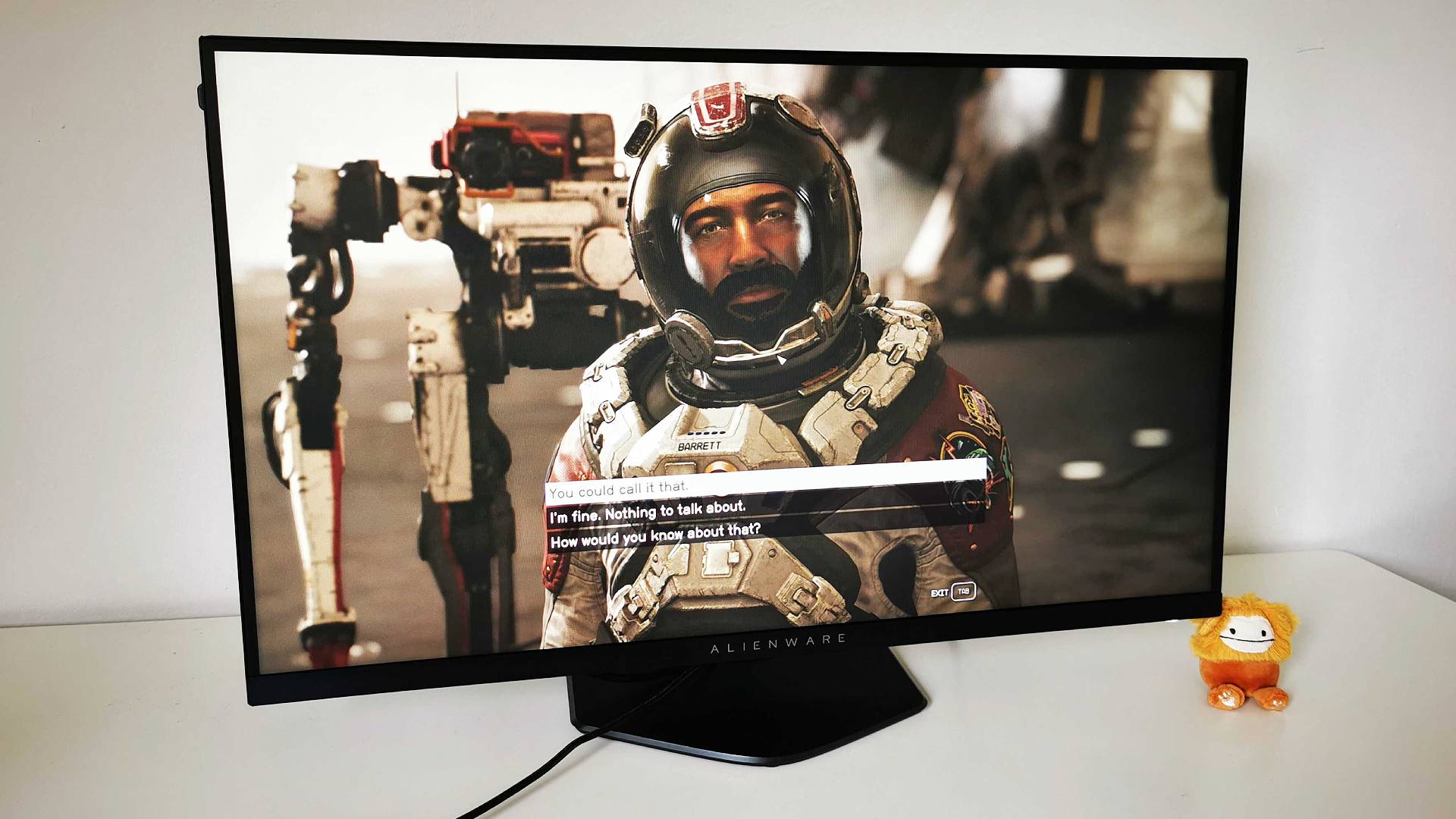
Circling back to the comments above, I’m not overly impressed by the color and contrast on show. Not to dunk too hard on Alienware’s screen, as it’s hardly going to hold up against some of the slower OLED models out there, but the visuals feel a little washed out. Enabling HDR helps with the contrast side of things, and that matters when you’re playing a wide variety of games. In any case, it’s clear that if you prioritize vivid colors and crispy contrast over refresh rate and responsiveness, this really isn’t the screen for you.
Before we close out, let's cover what you'll realistically need to take advantage of 360Hz in relatively new games. For this review, I decided to hook the screen up to my RTX 4080, and consistently hitting 360fps to match the panel's refresh rate was more challenging than I expected. I suspect I'd have better luck using the beefier Nvidia GeForce RTX 4090, but that sort of highlights a fundamental expense problem with playing at 360Hz.
I'm not saying you have to match a 360Hz display with the same frame rate to feel the benefits, as that'd be ludicrous. I guess rather than having me doubt this screen's worth, I've instead found myself wondering if I'd be able to make use of new Alienware 500Hz monitors now on the market. Ultimately, what I'm getting at is the fact you'll need expensive hardware to drive any of these high refresh rate gaming monitors, and you're more likely to get use out of a 360Hz model than the latter.
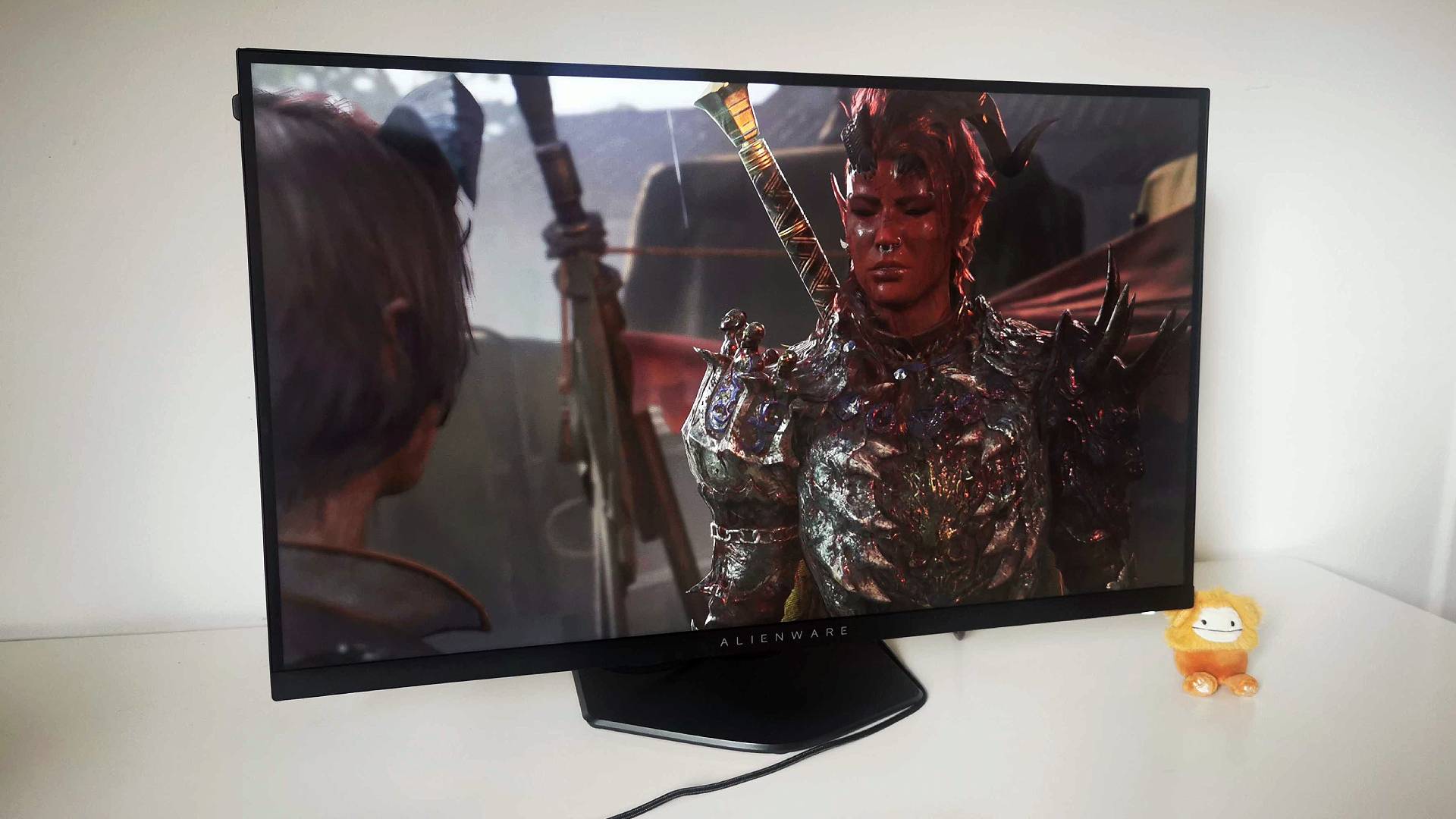
Should you buy the Alienware AW2724HF?
The Alienware AW2724HF is without a doubt one of the best Esports monitors you can buy, and it’s the snappiest screen I’ve used to date. Again, using the display at high frame rates has me wondering whether anyone needs fancy new 500Hz panels, as 360Hz feels like a natural ceiling. I’m sure future me and budding Esports pros will laugh at that previous claim, but time will tell if faster displays properly catch on.
Of course, opting for a super speedy screen comes with caveats, and 1080p is starting to show its wrinkles in 2023. The AW2724HF’s color and contrast capabilities also fall short compared to other models, so don’t pick this display up if you’re a creator or looking for a vibrant gaming experience.
How I tested the Alienware AW2724HF
Over two weeks, I used the Alienware AW2724HF as my main monitor for work and playing PC games. Using my personal rig armed with an RTX 4080, Intel Core i9-13900K, and 16GB, I played multiple rounds of Halo Infinite multiplayer and Overwatch 2. I also spent around 7 hours playing Baldur's Gate 3 and kickstarted my playthrough of Starfield using the display. All games were played at 1080p 360Hz with ultra settings, switching to low settings in Halo Infinite and Overwatch 2 for a few sessions to test maximum frame rate potential.
If you’d like to know more about how we handle all of our reviews, swing by our Hardware Policy for more details.
Looking for more premium panels? Check out our Best high refresh rate monitor picks for a range of speedy screens. Alternatively, take a look at the best 4K gaming monitors for high spec UHD displays.

I’m your friendly neighbourhood Hardware Editor at GamesRadar, and it’s my job to make sure you can kick butt in all your favourite games using the best gaming hardware, whether you’re a sucker for handhelds like the Steam Deck and Nintendo Switch 2 or a hardcore gaming PC enthusiast.
